Pink Toe Tarantula Care
Pink Toe Tarantulas are a popular beginner tarantula due to their docile and easy-to-care-for nature. While they do require proper care, as all pets do, the Pink Toe Tarantula requires minimal space and is overall relatively easy to care for.
These guys get their names from the beautiful little orange-pinkish toes that appear at the end of their legs. The little sprout of color makes it look like they have pink little toes.
They are fast-moving, bring native to the trees of South America, where they spend their time spinning elaborate webs. They are truly beautiful and interesting creatures to watch.
Housing them in a terrarium that mimics their natural habitat will bring out natural behaviors, which you will most likely want to experience.
They are docile, but all species of tarantulas can bite since they have fangs. However, they do not bite people and instead use their strong jaws and mild venom to kill their prey in a single bite.
There is so much more to learn about these interesting tarantulas, so continue reading to learn more about how to care for one as a pet:
Quick Reference Section
- Experience Level: Beginner
- Scientific Name: Avicularia avicularia
- Alternate Name(s): Pinktoe Tarantula, Guyana pinktoe, common pinktoe, or South American pinktoe
- Family: Theraphosidae
- Size: 3 to 5 inches
- Diet: Carnivorous
- Lifespan: 10 years
- Average Price Range: $20 to $40 per spider
- Where to buy: undergroundreptiles.com, backwaterreptiles.com
Bioactive Pink Toe Setup Product List
- Enclosure: Exo Terra Glass terrarium kit
- Soil: Zoo Med Reptisoil
- Moss: Zoo Med terrarium moss
- Hide: Zoo Med cork hide
- Leaf Litter: Sungrow leaf litter
- Hygrometer: Zoomed hygrometer
- Cleaners: Springtails & Isopods
- Water Dish: Zoo Med small water dish
Pink Toe Tarantula Facts
Pink Toe tarantulas are tree-dwellers that like to sit on trees or plants during the day and then hunt at night.
They are pretty inactive in general but are quite aggressive when it comes time for hunting.
They will throw their hairs as a warning or defense mechanism when threatened before even attempting to bite.
Appearance
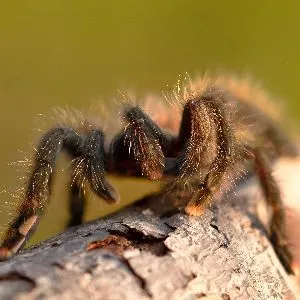
Pink Toe Tarantulas are mostly black in color and have pinkish or orange coloring at the tips of their legs, giving the illusion of pink toes. This is how they got their name.
Their hard-shelled black bodies are full of hairs, which can range from greys to blacks. They will also have a bit of green illumination to them in certain lighting.
They have eight beady little eyes and eight legs as well, of course. These tarantulas are medium-sized and will fit quite well on your hand.
Natural Habitat
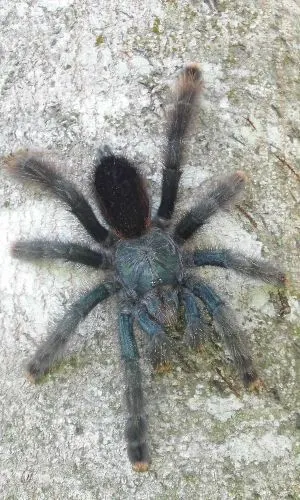
Pink-toed tarantulas are native to northern South American rainforests. They can be found in northern Brazil, Guyana, French Guiana, Venezuela, and Suriname. They are arboreal, meaning they live in trees.
They spend their time sitting in trees or on plants during the day until it comes time for them to hunt at night. They are active, aggressive hunters that use their size as an advantage to catch their prey.
Pink Toe Tarantula Diet
Pink Toe Tarantulas are carnivorous and aggressive hunters. They mostly feed on insects like grasshoppers, roaches, crickets, and wax moths. They like a good hunt; the more active the food, the more fun the chase.
They will sometimes enjoy small lizards such as Anolis or tree frogs, but these aren’t a major contributor to their diet in the wild. They should also not be a staple part of their diet in captivity.
How long do pink toe tarantulas live?
During the first year of a Pink Toe spiderling’s life, they are expected to molt about six times on average. Within 2 to 3 years, they should have already reached maturity.
Normally, males will have a shorter lifespan than females. Female Pink Toes can live up to 10 years, sometimes exceeding that in captivity whereas males may only live around 4 oy 8 years.
If you are taking care of your tarantula and meeting all their needs, you could be spending a lot of time with them, especially if she is female.
Breeding
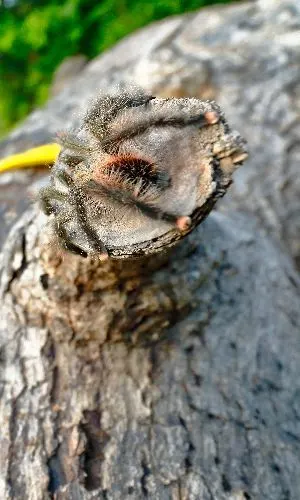
Female Pink Toe Tarantulas will lay anywhere from 50 to 200 eggs, which they will wrap in a silk-spun ball to protect.
Tarantulas mating is more like an aggressive transaction rather than a sexual experience. It is life or death for the male.
The male would have woven a pre-packaged silk ball with sperm, they will save it in their pedipalps, find a female mate, and then will attempt to deposit it into the female’s spermathecae, where she will store it.
However, this process may or may not happen if the female does not find the male worthy, as she will then react by cannibalizing him. If she finds a mate or worthy suiter, she will allow him to deposit his sperm web ball into her spermathecae, and copulation will commence.
If the male is successful, he has a few minutes to run away since female tarantulas will be entranced with chemicals right after fertilization. If he is unable to escape her during that short time, he might be her dinner.
The female Pink Toe may save the sperm until she has gone through her next molt and is ready to be fertilized. She may also just get right to business and drop her eggs as soon as she can.
She will then guard her protected clutch of eggs for a span of about 6 to 8 weeks, which is the average incubation period until they hatch.
Watch the tarantula’s mating ritual in the wild in a situation where the male is successful and gets away safely here:
Predators
In the wild, their most common predators are birds like hawks, eagles, and owls as well as weasels, skunks, spider-wasps, and snakes that feed on spiders.
Legality
In general, tarantulas are legal to keep in most states, although there may be local laws that restrict captivity, breeding, and such. Check out your local laws to find out what is and is not allowed in your state or city.
You can find them at pet stores easily, but we recommend you also try to look for a rescue group or at least make sure you buy from a licensed, reputable breeder.
Pink Toe Tarancuala Care Sheet
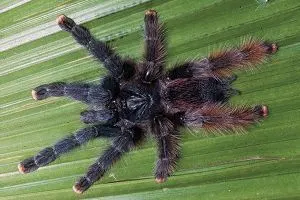
Enclosure
Bioactive Pink Toe Setup Product List
- Enclosure: Exo Terra Glass terrarium kit
- Soil: Zoo Med Reptisoil
- Moss: Zoo Med terrarium moss
- Hide: Zoo Med cork hide
- Leaf Litter: Sungrow leaf litter
- Hygrometer: Zoomed hygrometer
- Cleaners: Springtails & Isopods
- Water Dish: Zoo Med small water dish
The video below gives a full walkthrough on how to setup a bioactive enclosure for your Pink Toe tarantula.
Since Pink Toes are arboreal spiders, meaning they live in trees in their natural habitat, you’re going to want to worry about the height of your enclosure more than the width or length of it.
Suitable habitats for an adult should be around 12 by 12 by 18 inches at the very least. Exo Terra has a great one. You can house them in a large plastic container or in a 5 to 10-gallon vertically oriented tank.
Be sure, again, to provide plenty of height for them. Whatever you choose, it is also crucial that you give them adequate ventilation, as failing to do so can be fatal.
Substrate
Your Pink Toe Tarantula will prefer more humid climates, so you want to choose a moist substrate that will still allow for proper ventilation and prevent mold growth in order to keep your spider healthy.
There are good readily available options such as fir, coconut husk, potting soil, and sphagnum peat moss. These are all great choices for your pet tarantula.
The ones mentioned above in the list are what you will need for a bioactive enclosure, which we highly recommend setting up.
Springtails & Isopods
Springtails and isopods should be added to your biactive enclosure to clean up any leftover waste like dead crickets, fecal matter as well as molts.
Temperature
It is always best to try to mimic the environment your pet came from or would live in if they were in the wild. For Pink Toes, that means a wide range of temperatures between 60 to 80 degrees Fahrenheit.
However, an ideal closure for them should stay around the 78 to 82 degrees range, as this is the optimal range for their comfort.
Humidity
Pink Toe tarantulas come from humid climates, so you must try to maintain a good level for them to remain healthy. The optimal humidity levels for Pink Toes are between 65 and 75 percent. You can monitor it with a hygrometer like this one from Zoo Med.
Lighting
Pink Toes do not require UV rays or a lamp to stay healthy, however, they do need the temperatures to stay around 75 to 80 degrees Fahrenheit.
You may not need to worry about lighting if your home generally is around that temperature. You should just keep a digital thermometer on their enclosure to ensure their comfort and turn on the heater if needed.
In most cases, they should be fine as long as they are living around average room temperatures. A light would be unnecessary and might even bother them since they are nocturnal beings by nature.
Feeding
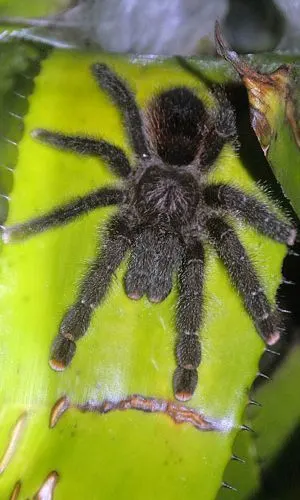
When feeding your tarantula in its enclosure, you need to consider its age first.
Younger spiders will need a few good-sized, gut-loaded crickets every 2 to 5 days whereas adults will eat the same amount but at the frequency of only every 3 to 10 days.
You can also switch up crickets for gut-loaded mealworms, superworms, and roaches, depending on your tarantula’s tastes.
Adults can also be given occasional snacks such as a pinky mouse or a small lizard. If you freeze these treats, be sure to allow them to warm to room temperature first.
Generally, you will find that you only need to feed them around once a week or so by the time they’re fully matured. Slings will have a bigger appetite.
Accessories
Adding some bark for them to climb is never a bad idea. A long slab that reaches from the bottom of the enclosure to the top can help make it feel more natural for them and will also add a naturalistic feel to your tank setup.
Real plants can always be a plus as well since they also like to sit on those.
Temperament
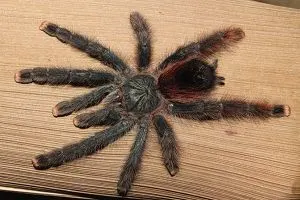
Pink Toe Tarantulas are laid-back and will spend most of their time quietly chilling in their terrarium. They are very active and skittish creatures.
Although they don’t move much, they may be startled while you are handling them and their first reaction is to jump out of your hands. This is why it is recommended that you handle them while sitting on the ground.
Again, they are aggressive when feeding time comes around, so they will be a lot more active during those times.
In general, they are very docile creatures when it comes to humans. They are, however, a little jumpy by reputation so keep that in mind.
Handling
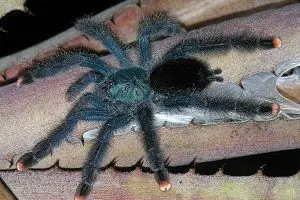
The biggest tip to handling your pet tarantula is not to do it too much too often and to keep a close eye on their reaction. You don’t want to stress them out.
When they get defensive, they will shed hair before they even try to bite, but you don’t want this to happen. You should try your best to gauge their comfort and take it slowly.
Check out this informative video and demonstration of tricks and tips for handling your Pink Toe here:
Overall, some owners may want to handle their spiders more than the spider wants to be handled, but as long as you’re being thoughtful to your tarantula’s needs and moods, you should be able to handle them.
You must do it calmly and gently so that these skittish spiders don’t get startled and jump out of your hand, which can cause injury and may even be fatal.
They may also bite if you make them feel defensive enough, which can be a very painful experience.
FAQ
Are Pink Toe Tarantulas good for beginners?
Yes! These tarantulas a popular amongst beginner enthusiasts and experts alike. They are typically considered good beginner pet spiders.
Where can I buy a Pink Toe Tarantula?
Go ahead and check out some of the websites we listed, as one of them should have them in stock for a price that suits you. Make sure you look at the picture and you should be able to ask questions to the breeder or seller.
We recommend Underground Reptiles and Backwater Reptiles.
Pink Toe Tarantulas should be priced at around $20 to $40 per spider, depending on their morph, gender, size, and age.
Are Pink Toe Tarantulas poisonous?
Although these spiders will not usually try to bite you, they may try to if they feel defensive when you handle them.
They do have venom that is slightly toxic, but it will only rarely cause any systematic reaction to humans. If you were to get bit by one, you may have a bite mark or might see some redness or swelling at most.
Although, it will be a painful experience since they have very large fangs. They say it’s as painful as a wasp sting!
It will hurt a lot, but you won’t die from it.
Conclusion
Pink Toe tarantulas are beautiful creatures that can make great pets to show off to your friends or watch.
If you give them a good home with adequate temperatures and feed them well, they will be comfortable and happy in their enclosure.
We hope this helped you in your preparation for your new pet tarantula or maybe confirmed your decision to get one or not.
Whether you are a beginner or an expert in tarantulas, enthusiasts always have their sights set on the Pink Toe!
More tarantulas stuff
Table of Contents
